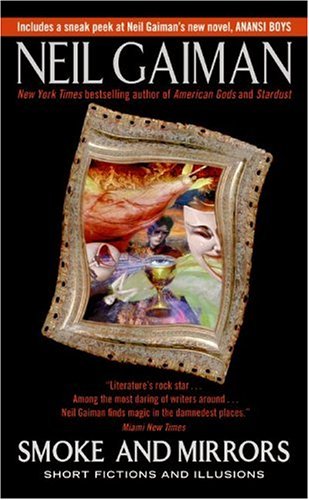Written by Sam Leaden
Near the beginning of this week, I was asked to write a list of books that I have read recently and send them in to see if any were review-worthy. At the top of the list was Neil Gaiman’s “Smoke and Mirrors.” I put this on the list, not thinking that I would actually write a review for it, but just to show another book which I have read. When asked to tell more about this book, I was immediately hit with anxiety and presented with a dilemma. Before I explain the problem of writing a review for this book is, let me tell you more about the novel itself.
Gaiman, is a British modern science fiction and fantasy writer who has been popular in several different genres of art (comics, novels and screenplays) since the mid ‘80s. He has been lately popular for having one of his children books, “Stardust” adapted into a motion feature (terrible movie, but pretty ok book, by the way).
“Smoke and Mirrors,” a collection of short stories and some poems, was published in the late ‘90s. Each story is different and refreshingly unique; they never build on each other. In the introductions, Gaiman writes one or two paragraphs setting up each story and often records how he came to write it, being inspired by things from strange statues to strangers’ glances on the train. The stories cover vastly different topics, each set in reality but given a slight hint of an illusion of fantasy, giving the anthology its name, “Smoke and Mirrors.” The title implies that everything might look like a magic trick, but in the end the performance is only fooling your senses.
This is the third Gaiman book that I have read and, personally, I think he is an amazing modern writer. My only problem with this book is that there are sections where it hints to adult content, and then there are sections where there is adult content. The whole book is not like this, and the introductions sometimes imply the content, but if I look past this I am able to enjoy the rest of the book.
This is where my book review dilemma comes into play. I am torn between defending this book and shielding it from other people. I don’t want people to judge the whole book because of one or two stories; they would miss the big picture. Then again, I don’t want every student who goes out and reads this book to ignore its flaws.
In defense of this book, let me compare it to something which will hopefully make you think. When you think of your favorite movies, how many of them are R-rated? How many of them have sex scenes, language and violence? Why is it taboo for books to have adult content, but socially acceptable for movies to have it? Is there such a difference between scanning your eyes over a page to scanning your eyes over a screen?
Every person could answer this slightly differently; I don’t think that there is just one flat answer these questions. I do think that there is little to no difference between movies and books. Every person must follow their own conscience in this respect, but if you can take the good and discard the bad, I recommend this book.







